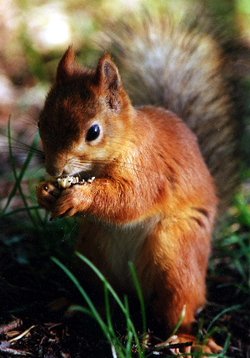Red Squirrel
|
|
| Red Squirrel | ||||||||||||||||||
|---|---|---|---|---|---|---|---|---|---|---|---|---|---|---|---|---|---|---|
 | ||||||||||||||||||
| Scientific classification | ||||||||||||||||||
| ||||||||||||||||||
| Binomial name | ||||||||||||||||||
| Sciurus vulgaris Linnaeus, 1758 |
The Red Squirrel, Sciurus vulgaris, is a common European tree squirrel. It is still frequently found on the European continent and across Asia but has been widely replaced by the Eastern Grey Squirrel in Great Britain. They are tree-dwelling omnivorous rodents.
| Contents |
Appearance and physiology
Red Squirrels have a typical body length of 19-23 cm and mass of 250-340g when fully grown (compare with the 25-30cm, 400-800g of the Eastern Grey squirrel), and have a tail which can be up to 20 cm long itself, almost as long as the body. It is thought that this helps the squirrel to balance and steer when jumping from tree to tree and running along branches and keep the animal warm during sleep.
The coat of the red squirrel varies in colour with time of year and location. There are several different coat colour morphs ranging from black to red. Although only red coats are found in Great Britain, in other parts of Europe and Asia the different coat colours co-exist within populations, much like hair colour in humans. The underside of the squirrel is always white-cream in colour. Red Squirrels shed their coats twice a year, switching from a thinner summer coat to a thicker, darker winter coat with noticeably larger ear-tufts (a prominent distinguishing feature of this species) in August-November. A lighter, redder overall coat colour, along with the larger ear-tufts helps to distinguish the European Red squirrel from either the Grey squirrel or the American Red Squirrel, Tamiasciurus hudsonicus.
The red squirrel, like most tree squirrels, has sharp, curved claws to enable the climbing of trees, even when branches are overhanging.
Their lifespan is about 2-3 years.
Habitat and lifestyle
Native to usually coniferous, though often broadleaved woodlands, the tree squirrel makes a nest, known as a drey in a branch-fork of a conifer by laying down twigs to make a domed structure about 25-30cm in diameter, then lining it with moss, leaves, grass and bark. Hollows and woodpecker's nests are also used. Although solitary animals, shy and reluctant to share food with others, outside of the breeding season, and particularly in winter, multiple red squirrels may share a drey to keep warm.
Red squirrels eat mostly the seeds of trees, neatly stripping conifer cones to get at the seeds within. Fungi, birds' eggs, berries and young shoots are also eaten. Often the bark of trees is removed to allow access to sap. Excess food is put into caches, either buried or in nooks or holes in trees and eaten when food is scarce. No territories are maintained, and the feeding areas of individuals overlap considerably.
The active period for the red squirrel is in the morning and late afternoon-evening. They often rest in their nests in the middle of the day, avoiding the heat and the high visibility to birds of prey that are dangers during these hours. During the winter, this mid-day rest is often much more brief, or absent entirely, although harsh weather may cause the animal to stay in its nest for up to days at a time.
Breeding
Breeding may not occur if food supplies are low. This is a worry to conservationists in the UK, as competition with grey squirrels is thought to be significantly affecting the amount of food available there. Mating can occur in Late Winter (February-March) and Summer (June-July), and up to two litters a year per female are possible. Each litter usually contains 4-8 young, although 3 is usual. Gestation is about 38-39 days. The young are looked after by the mother alone, and are born helpless, blind and deaf. Their eyes open after 3-4 weeks, weaning occurs at 7-10 weeks, during which time the young leave the nest on their own to find food, but still suckle from their mother.
During mating, males detect females that are in strus, and chase them through the trees. Usually, many males will end up chasing a single female in this manner, until one is selected and allowed to mate with her.
Conservation
Template:Commons Although not thought to be under any threat worldwide, the red squirrel has drastically reduced in numbers in the UK. Under 200,000 individuals are thought to be left. This is likely due to the introduction of the Eastern grey squirrel from North America, although the destruction of its native woodland habitat is also blamed.
The Grey squirrel appears to be able to out-compete the red squirrel for various reasons:
- The grey squirrel can easily digest acorns, while the red cannot.
- The grey squirrel carries a disease, the parapox virus, that does not appear to affect their health, though will kill most red squirrels.
- As mentioned above, when red squirrels are put under pressure, they will not breed so often, this decreases their numbers even more.
It is worth noting that Grey squirrels do not usually attack Red squirrels, and direct violent conflict between these species is not a factor in the decline in red squirrel populations.
In Slovenia, the red squirrel is one of the protected animal species. Although currently its status is stable there, it could potentially become endangered.da:Almindeligt egern de:Europäisches Eichhörnchen pl:Wiewiórka pospolita
